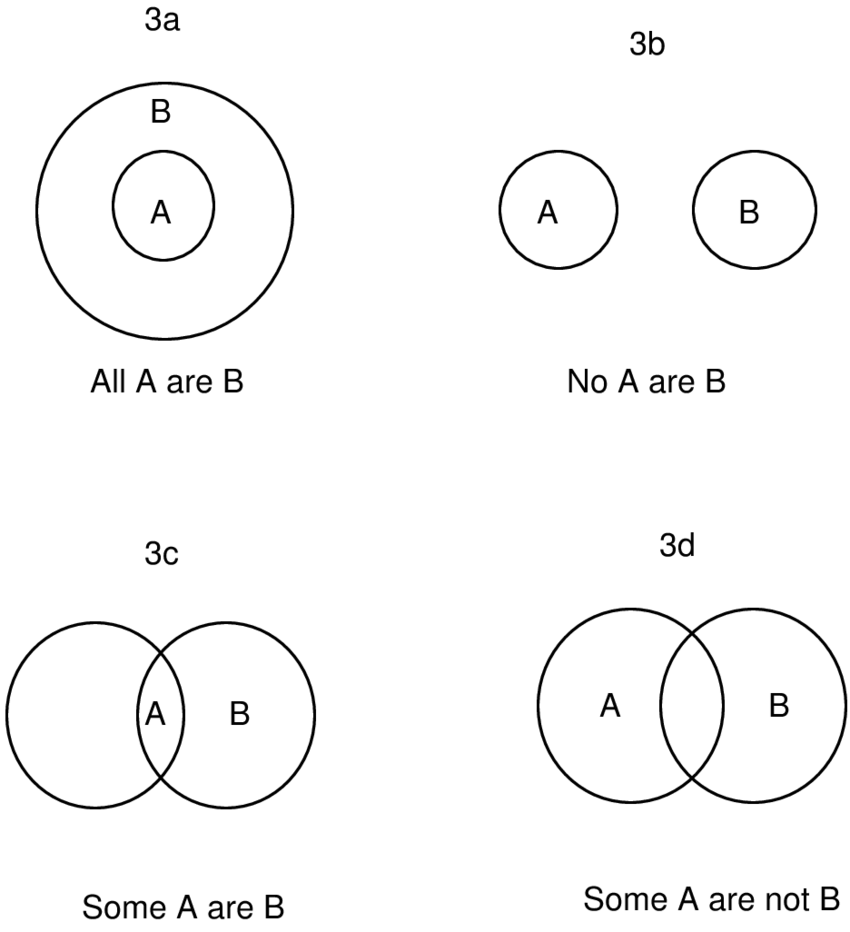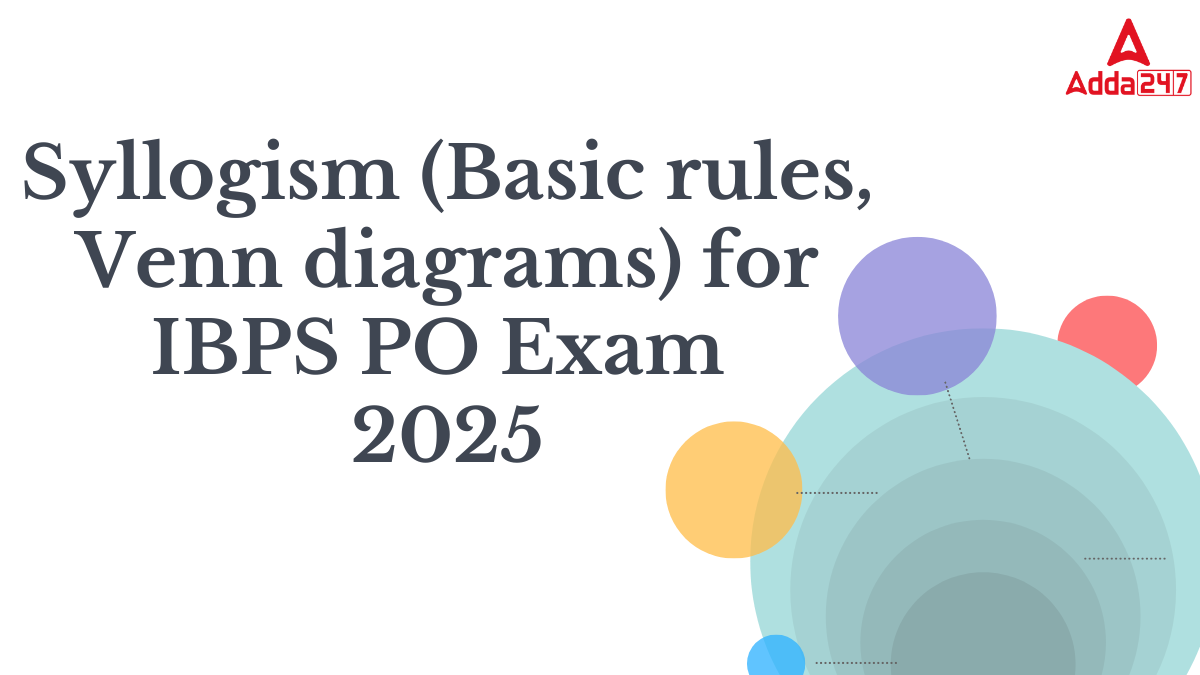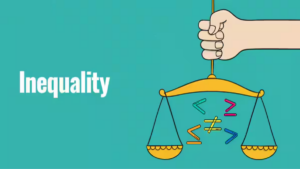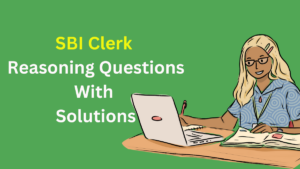Syllogism is a key topic in the Reasoning Ability section of the IBPS PO Exam 2025, both in Prelims and Mains. It tests a candidate’s logical reasoning skills and the ability to draw valid conclusions from given statements. Although the concept is simple, the options can be confusing if you’re not well-versed in its basic rules. With the rise of new pattern questions, understanding traditional syllogism using Venn diagrams is even more crucial, as it lays the foundation for solving both old and new types quickly and accurately.
Syllogism for IBPS PO 2025
A syllogism is a form of logical reasoning where conclusions are drawn from two or more statements (also called premises). These statements use universal and particular quantifiers such as all, some, or no. Your job is to evaluate whether the conclusions logically follow the given statements.
Types of Statements in Syllogisms
| Types of Statements in Syllogisms | ||
| Statement Type | Structure | Example |
| Universal Positive (All A are B) | All A → B | All cats are animals. |
| Universal Negative (No A is B) | No A → B | No dog is a cat. |
| Particular Positive (Some A are B) | Some A → B | Some birds are parrots. |
| Particular Negative (Some A are not B) | Some A → ¬B | Some apples are not red |
Basic Rules of Syllogism
To solve syllogism questions correctly, follow these 5 fundamental rules:
Rule 1: All → Some
If “All A are B,” then “Some A are B” is automatically true.
Example:
Given: All dogs are animals.
Conclusion: Some dogs are animals. (Valid)
Rule 2: No → No & Some Not
If “No A is B,” then:
“No B is A” (Reverse is true).
“Some A are not B” is always true.
Rule 3: Some → Some (Reversible)
If “Some A are B,” then “Some B are A” is also true.
Example:
Given: Some birds are parrots.
Conclusion: Some parrots are birds. (Valid)
Rule 4: Some + No = No Conclusion
If one statement is “Some” and the other is “No,” no definite conclusion can be drawn.
Rule 5: Two Particular Statements → No Conclusion
If both given statements are “Some” or “Some…not,” no valid conclusion follows.
Understanding “Only”, “Few” and “Only a Few” Statements of Syllogism
Only A are B
This means All B are A, but it doesn’t imply All A are B.
Example: “Only cats are pets” = All pets are cats.
Only a Few A are B
This implies: This is a hybrid case that explicitly denies a complete overlap.
Some A are B, and
Some A are not B.
Few A are B
In syllogism, “Few” is generally treated like “Some”- meaning at least one but not all. But it can subtly indicate that some A are B, with a suggestion (not certainty) that some are not.
Examples:
Example 1: Statements:
Few laptops are durable.
All durable items are expensive.
Conclusions:
Some laptops are expensive.
Most laptops are not expensive.
Answer:
Conclusion 1 (Valid – Few → Some overlap).
Conclusion 2 (Invalid – “Most” cannot be confirmed).
Example 2: Statements:
Most Indians are cricket fans.
Some cricket fans love football.
Conclusions:
Some Indians love football.
No cricket fan is Indian.
Answer:
Conclusion 1 (Possible but not definite).
Conclusion 2 (Invalid– contradicts given statements).
Using Venn Diagrams to Solve Syllogisms
Venn diagrams are the most reliable method to solve syllogism questions. They visually represent the relationship between sets (or groups) mentioned in the statements. Here’s how to draw Venns for each type:
All A are B → Circle A completely inside B.
No A is B → Two circles A and B that do not touch.
Some A are B → Overlapping part between A and B.
Some A are not B → Part of A lies outside B.

Steps to use Venn diagrams:
- Read and understand all the statements clearly.
- Draw a diagram based on the structure of the statements.
- Examine each conclusion against the diagram.
- Mark the conclusions that definitely follow.
- Use simple circles; don’t overcomplicate.
- Use overlaps carefully—only when “some” is involved.
- Don’t assume intersections unless explicitly stated.
- For “no” statements, never let the circles touch.
Common Mistakes to Avoid
- Assuming “Some A are B” implies “Some B are A” (not always valid).
- Thinking “Few” means “very few” — treat it as “some” in logic.
- Misinterpreting “Only” statements as “All”.
- Jumping to conclusions without drawing a Venn diagram.
- Overlooking conclusions that are possibly true but not definitely true.
Practice Approach for Syllogism
- Start with two-statement basic problems.
- Gradually move to three-statement and new-pattern questions.
- Focus on possibility-based, “either-or”, and “only a few” cases.
- Regularly solve questions from previous year papers and mock tests.
- Analyze incorrect answers to understand reasoning gaps.
Syllogism Questions for Practice
Directions (1-5): In each of the questions below some statements are given followed by some Conclusions. You have to take the given statements to be true even, if they seem to be at variance from commonly known facts. Read all the conclusions and then decide which of the given conclusions logically follows from the given statements disregarding commonly known facts.
(a) If only conclusion I follows
(b) If only conclusion II follows
(c) If either conclusion I or II follows
(d) If neither conclusion I nor II follows
(e) If both conclusions I and II follow
Q1. Statements: Some Reference is Review
Some Review are leader
Only a few leader are money
Conclusions: I: All leader can be money
II: Some Review are Money is possibility
Q2. Statements: No Ram is rom
All Ram is Mango
All Rom is apple
Conclusions: I. Some Mango are not Apple
II: Some apple are not Mango
Q3. Statements: Only a few circle are triangle
No triangle are Square
Some Square is Hexagonal
Conclusions: I: All circle can be triangle
II: Some square are circle
Q4. Statements: All Bank are Court
All Court are Legal
Some legal are Eagle
Conclusions: I. Some Bank are Legal
II: Some Eagle are Court
Q5. Statements: All coal are petrol
Some petrol are Diesel
All Diesel are Bike
Conclusions: I. Some Petrol are not Bike
II: All Petrol are Bike
Directions (6-10): In each of the questions below some statements are given followed some conclusions. You have to take the given statements to be true even, if they seem to be at variance from commonly known facts. Read all the conclusions and then decide which of the given conclusions logically follows from the given statements disregarding commonly known facts.
Q6. Statements: Only Happy are Sad.
Only a few Anger are Happy.
No Anger is Hate.
Conclusions: I. All anger is happy is a possibility.
II: All hate are happy is a possibility.
(a) Only I follows
(b) Both I and II follow
(c) Only II follows
(d) Either I or II follow
(e) None of these
Q7. Statements: All Planet are Earth.
All Earth are Mars.
Only a few Moon are Mars.
Conclusions: I. All Moon are Planets is a possibility.
II: All Mars are Moon is a possibility.
(a) Only I follow
(b) Only II follow
(c) Either I or II follow
(d) Both I and II follows
(e) None of these
Q8. Statements: Some research are science.
All science is human.
No science are species.
Conclusions: I. Some species are research is a possibility.
II: No human are research is a possibility.
(a) Only I follow
(b) Only II follow
(c) Either I or II follow
(d) Both I and II follow
(e) None of these
Q9. Statements: Only a few jasmine are lotus.
Only lotus are tulip.
Only a few lotus is daisy.
Conclusions: I. All daisy is jasmine.
II: Some daisy are not jasmine.
(a) None follows
(b) Only I follows
(c) Only II follows
(d) Either I or II follow
(e) None of these
Q10. Statements: No river are ocean.
All ocean is sea.
No sea is jungle.
Conclusions: I. Some sea is river.
II: All jungle are ocean.
(a) Both I and II follow
(b) None follows
(c) Either I or II follow
(d) Only II follow
(e) Only I follows
| Related Post | |
| Reading Comprehension Tips for IBPS PO Exam |
|
| IBPS PO Exam Date | IBPS PO Syllabus |
| IBPS PO Preparation Strategy | IBPS PO Salary |
| IBPS PO Eligibility | IBPS PO Mock Test |




 Inequality Tricks for Beginners, Easy Me...
Inequality Tricks for Beginners, Easy Me...
 Reasoning Questions for SBI Clerk Mains ...
Reasoning Questions for SBI Clerk Mains ...
 500+ Reasoning Questions PDF for SBI Cle...
500+ Reasoning Questions PDF for SBI Cle...








